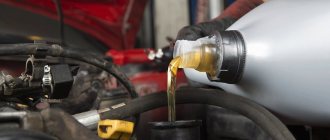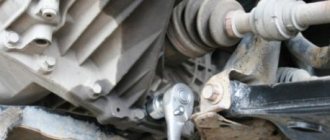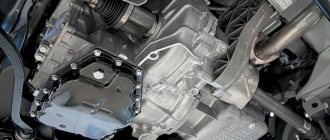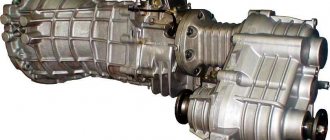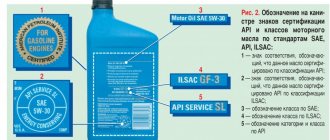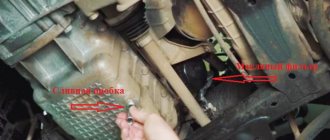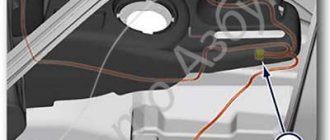In 2002, GM-AvtoVAZ began serial production of the Chevrolet Niva. This model has retained all the advantages of the old Niva - the presence of permanent all-wheel drive, a locked center differential, as well as a two-speed manual gearbox.
Chevrolet Niva has 6 trim levels, namely: L, LC, LE, GL, GLC and LE+. The last of them was presented in 2015. It differs from the rest in the presence of air conditioning, a full safety package, Continental Cross Contact tires, K&K “Camelot” wheels, special rear bumper protection, a towbar, as well as unpainted moldings.
To make driving easier, the manufacturer equipped the car with hydraulic power steering (power steering).
Let's look at what fluids are used in power steering Niva Chevrolet, how to check the oil level and replace it yourself.
Types of power steering fluids for Chevrolet Niva
The original working fluid for power steering Niva Chevrolet is Pentosin CHF 11S.
Among its analogues we can note PSF, which has almost the same characteristics, but at a more reasonable price. Pentosin is green, PSF is red or yellow.
In addition to the mentioned oils, it is worth highlighting Mannol Dexron III. This fluid is multi-purpose - it can be used not only in power steering, but also in automatic transmissions, clutches, and other similar mechanisms. Dextron has good low-temperature and antioxidant properties and an increased service life.
Is it possible to fill the power steering with engine oil?
To understand whether other oils, such as motor or transmission oils, can be poured into the power steering, you need to know what functions it performs.
- Lubrication of all power steering components;
- Protection against corrosion and wear of parts;
- Pressure transfer;
- Prevents foaming;
- System cooling.
The above characteristics are achieved by adding various additives, the presence and combination of which gives power steering oil the necessary qualities.
Regarding transmission oil, everything is not so clear; the Japanese often use the same ATF fluid for automatic transmission and power steering. Europeans insist on using special PSF (Power Steering Fluid) oils.
Frequency of power steering fluid replacement
It is believed that the oil that was filled into the power steering of a Chevrolet Niva does not require replacement throughout the entire life of the vehicle. However, if there is damage to the steering rack, various contaminants may enter the system.
Over time, the fluid forms sediment, which affects its quality; the temperature difference between winter and summer also negatively affects the condition of the oil in the power steering. This is why it needs to be replaced approximately every six years, regardless of condition.
Liquid composition
Based on the composition of the power steering fluid, it can be divided into mineral, semi-synthetic and synthetic. The chemical composition determines the basic set of oil functions:
- Viscosity characteristics;
- Lubricating properties;
- Protection of parts from corrosion;
- Prevents foaming;
- Temperature and hydraulic properties.
Synthetics and mineral water cannot be mixed with each other, since the types of additives in them have fundamental differences.
Synthetics
These are high-tech liquids, in the production of which the most modern developments and additives are used. Oil fractions for synthetics are purified by hydrocracking. Polyesters, polyhydric alcohols and sets of additives give them outstanding characteristics: a wide range of operating temperatures, stable oil film, long service life.
Semi-synthetics
A mixture of synthetic and mineral oils, due to which the latter receive significant improvements in performance: reduced foaming, fluidity, heat dissipation.
Mineralka
Mineral-based oils contain petroleum fractions (85-98%), the rest are additives that improve the performance of the hydraulic fluid.
They are used in hydraulic boosters containing seals and parts based on ordinary rubber, since the mineral component is neutral and is not harmful to rubber products, unlike synthetics.
Checking the fluid level
The power steering reservoir in the Niva Chevrolet is installed on the left side of the engine compartment. It is connected to the pump and steering mechanism by flexible hoses.
To check the fluid level in the reservoir, unscrew the cap.
The oil should reach the middle of the segment between the marks on the dipstick.
Main elements of the system
The largest and most basic element is the fuel tank, but the total number reaches sixteen. Their volumes vary greatly.
- They are necessarily included in the engine cooling and lubrication systems.
- Axle housings and gearboxes are also extremely important for safety during travel.
- Chevrolet Niva filling tanks include power steering systems and hydraulic brake lines, front and rear shock absorbers.
- An integral part are tanks for windshield washer and air conditioning.
Do-it-yourself power steering fluid replacement
To change the fluid in the power steering, unscrew the clamp bolt of the bracket, loosen the clamp of a suitable hose and remove the reservoir to remove the old oil into a previously prepared container.
Start the engine and turn the steering wheel 3-4 times in different directions until it stops. As the liquid drains, add fresh liquid.
Repeat the operation until new oil begins to come out of the outlet hose.
Reinstall the reservoir and check the fluid level - it should be at the top mark of the dipstick.
Lubrication system.
The lubrication system itself is also combined. The oil pump supplies oil under pressure to the bearings, crankshaft, and drive helical gear. Some parts are lubricated by splashing.
- The engine lubrication capacity is 3.75 liters.
- It is better to use synthetic and semi-synthetic SUPER oil. Its viscosity class: from -25 to 30, 35 - 5W30, 5W40; from -15- 45 - 15W 40; from -10- 45 - 20W 40.
- Transmission oils from Lukoil TM-4 are made on a mineral (80W 85, 80W-90) and semi-synthetic base (75W-90) and are off-season, high-quality, as they use additives from the world's best manufacturers. They are needed for gearbox housings (1.6 l).
- The same oil is used for the transfer case (0.79 l).
- For the front (1.15 l) and rear (1.3 l) axles, 80W 90 and 85W 90 are used.
- The 1.7 liter power steering requires Pentosin Hydraulic Fluid CHF115.
- The hydraulic front shock absorber (0.15 l) and rear shock absorber (0.215) are filled with Slavol-AZh or GRZh-12 operating fluid.
High temperatures, constant loads and friction affect the service life and operating time of the motor. Without lubrication, gears and parts wear out quickly. In addition to cooling, it is possible to eliminate carbon deposits and microparticles.
Read news about the new field
- Quantity of oils and fuel liquids VAZ 4×4 2121 Niva
- Volume of oils and liquids chevrolet niva
- Changing the oil in the Niva 21214 engine
- How much oil is in the Niva 21214 engine
- Changing the oil in the VAZ 21214, 21213 (Niva) engine: instructions, volume
- Quantity of oils and fuel liquids VAZ 4×4 2121 Niva
- How to fix an oil leak from a gearbox
- How much oil is in the Niva 21214 engine
Bleeding the system
To bleed the power steering system on a Chevrolet Niva, place the steering wheel in the middle position and start the engine for a few seconds. Do not turn the steering wheel. After this, turn off the car and turn the steering wheel all the way in any direction.
Remove the protective cap from the special valve using a wrench to bleed any remaining air from the system.
Then turn the steering wheel in the other direction, leaving the air bleed valve open. After the air lock and some liquid come out, close the valve. If necessary, add power steering fluid to the maximum mark. Start the engine and turn the steering wheel in different directions until it stops. Do this until air bubbles stop escaping into the tank.
How to pump power steering
How to fill oil and bleed power steering
- Raise the vehicle completely on a lift or with the front wheels off the ground.
- If necessary, drain the old fluid from the expansion tank. To do this, remove the return hose (going to the power steering system) from the expansion tank and put a plug on it so that liquid does not spill out of the hose. A hose leading to an empty bottle is connected to the released tap on the tank, where the old hydraulic fluid is supposed to be drained.
- It is most convenient to pump out the main volume of liquid with a syringe and pour it into a separate bottle. When there is very little liquid left, move on to the next point.
- Fill the expansion tank with working fluid to the top.
- Next, you should turn the steering wheel from side to side (from lock to lock) several times so that the old fluid remaining in the system flows out through the hose. Since the new fluid displaces the old, do not forget to monitor the oil level in the tank so that air does not get into the hose.
- If the fluid level drops, add it again.
- Start the engine for 2-3 seconds and turn it off. This is done so that the liquid begins to spread throughout the system.
Pumping out oil with a syringe
- Next, add working fluid to the tank to the MAX level and repeat the procedure by starting the engine. Repeat this cycle 3-5 times.
- The signal to stop pumping is the fact that air from the return hose stops entering the drain bottle. This means that there is no more air left in the hydraulic system and fresh, clean fluid enters the reservoir.
- After this, you need to reinstall the return hose (connect it to the expansion tank where it was originally installed).
- Refill the reservoir to the MAX level, then start the engine.
- To pump the hydraulic booster, you need to slowly turn the steering wheel 4-5 times from the left to the right stop. At the stop points, pause for 2-3 seconds. If there is any air left, it should escape into the expansion tank. During the inspection process, we make sure that the pump does not make any extraneous noise.
- An indicator that pumping has ended will be the absence of air bubbles on the surface of the liquid in the tank.
- After this, close the expansion tank tightly.
Bleeding the power steering system
can also be pumped without starting the engine , “cold”. To do this, just rotate the steering wheel from the left to the right stop . At the same time, old fluid and air leave the system. However, most automakers still recommend bleeding the system with the engine running.
Replacing power steering fluid on a Chevrolet Niva
Power steering fluid performs one of the most important functions of a car - it makes it easier to turn the steering wheel, which in turn allows the driver to adjust the trajectory of movement. However, like any other oil, hydraulic fluid requires timely replacement. We will tell you below how to change the oil in a Chevrolet Niva yourself.
Selecting oil for filling into the power steering for a Chevrolet Niva
Hydraulic fluid in a Chevrolet Niva is oil that transmits resistance from the pump to the hydraulic cylinder. This mechanism makes it easier to turn the steering wheel. In addition, the product lubricates car parts and prevents them from wearing out.
Oil circulation through the power steering system occurs through connecting units and hoses. The mixture level is indicated on the expansion tank with MIN and MAX marks. So every motorist should monitor the amount of oil and add it in a timely manner. Otherwise, the system will fail, and its repair will be expensive.
Driving a vehicle without hydraulic fluid will damage the pump, which is an expensive part. As a result, the power steering mechanism will not be able to work. If the Chevrolet Aveo is left without oil in the power steering system, you need to call a tow truck.
If the power steering fails, it is possible to drive the car, but the steering wheel will be difficult to turn.
Driving without hydraulic booster mixture puts you at risk of breaking the pump, which costs a lot of money, as it will run dry. As a result, the part fails prematurely.
Like any other fluid, hydraulic oil loses its properties over time. According to the regulations, replacement is required every 100 thousand km or once every 2-3 years. In addition, the power steering system may fail for other reasons, in which case new oil is added.
Signs that the power steering fluid needs to be replaced:
- Feeling of reverse shocks on the steering wheel. If the pump drive belt is tense or worn, it must be replaced, and then the power steering solution must be changed;
- The steering wheel turns with great effort or, on the contrary, too easily;
- The mixture in the tank has lost its original color;
- Feeling a burning smell;
- Low level of solution in the system;
- Low engine idle speed;
- Dirty tank filter;
- Low operating pressure of the power steering pump;
- Availability of air in power steering.
Frequent use of a Chevrolet Niva car leads to a change in the color of the solution. This is the main reason for changing the power steering oil. You should also not leave the car with the steering wheel turned all the way in the parking lot, as this leads to premature wear of the parts.
The driver must promptly check the power steering system, as well as:
- control the oil level, its color and quality;
- check the tension of the drive belts on the power steering pump;
- check hoses for leaks.
The process of changing the oil in the power steering
Replacing power steering fluid in a Chevrolet Niva is carried out in the following ways:
- partial oil change;
- Complete replacement of power steering fluid.
The replacement method is determined depending on the initial state of the liquid in the tank.
In order to partially change the fluid, you will need a syringe, a rubber tube, and 1.5 - 2 liters of oil.
The procedure for partially replacing the fluid in the power steering:
- Unscrew the valve of the power steering plastic expansion tank;
- Draw out the liquid using a syringe and tube;
- Fill in new fluid to the maximum mark;
- Start the engine and turn the steering wheel several times until it stops;
- Stop the engine, pump out the oil and fill in new oil.
The procedure is repeated until the solution that flows out is clean.
Step-by-step process of draining the old fluid and adding new one
In order for the power steering system to work properly, it is necessary to completely replace the power steering fluid every 3 years. The procedure is as follows:
- Raise the front wheels of the car on a jack so that no pressure is exerted on them;
- Open the hood and secure it;
- Remove the power steering reservoir cap and remove the filter located inside;
- Clean the filter from dirt and deposits using a special product;
- Next, pump out the old solution from the tank using a syringe;
- The hoses are disconnected, the contents are poured into an empty container;
- Start the car engine and turn the steering wheel several times;
- After all the fluid has been removed from the power steering, you can begin to fill in new oil.
After the oil is poured into the expansion tank to the maximum mark, it is necessary to distribute the mixture throughout the entire power steering system. To do this, the steering wheel is turned all the way to the right and left. The oil level will drop at this moment. If necessary, add liquid.
Bleeding the hydraulic clutch of Niva Chevrolet
If, when the pedal is pressed all the way, the clutch does not disengage completely (“drives”), which is accompanied by a characteristic grinding of gears when engaging reverse gear, there may be air in the clutch hydraulic drive. Remove it by bleeding the drive. In addition, pumping is performed when the hydraulic drive is filled with fluid after its replacement or after repair of system components associated with its depressurization.
You will need: an “8” wrench, a bleeder hose, a container for brake fluid, brake fluid.
Carry out the work with an assistant in the inspection ditch.
1. Pour (or add) liquid into the tank to the bottom edge of the filler neck.
2. Place a bleeder hose onto the slave cylinder valve. Place the other end of the hose in a container with a small amount of brake fluid so that it is submerged in the fluid.
Cooling systems.
The cooling system here is liquid, closed type. This includes a radiator, pump, sensor. thermostat, fan, expansion tank, hoses, etc. The capacity is 8 liters.
The expansion tank is located next to the brake booster. Installed markers allow you to quickly determine the fluid level. It is important that everything is completely sealed, so the inlet and outlet valve monitor and regulate the pressure.
The tubular-plate radiator is made of aluminum and has plastic tanks. Coolant Antifreeze A-40 M for this system is poured through the expansion tank.
Also interesting: Niva car steering gear
Design and replacement of the Chevrolet Niva power steering pump
Today, it is probably impossible to imagine a modern car without power steering. Even if such transport occurs, it is attributed to the last century. Its presence simplifies wheelbase control, and considering that the Chevrolet Niva is an SUV, its presence is necessary, since its weight is more than one and a half tons, and the roads leave much to be desired.
Sometimes it happens that the power steering pump fails; the Chevrolet Niva is no exception; if this happens, then this breakdown should be repaired immediately, as this can lead to the steering wheel simply jamming. Repairs can be made at a specialized car service center, but this is not a cheap pleasure, so many people carry out the repairs themselves. But in order to repair the gyroscope with your own hands, you need to know its structure.
Tools:
- Flat screwdriver
- Phillips screwdriver
- Socket wrench 13
- Open-end wrench 13
- Socket wrench 22
- Socket wrench
- Extension for socket wrench
- Head for socket wrench 13
- Head for socket wrench 22
Parts and consumables:
- Power Steering Pump
- Copper washers 2 pcs
- Power steering fluid
Note: If the new pump does not come with a hose connection, remove the connection from the old pump and install it in the new one.
We carry out the work on an inspection ditch or overpass.
1. Remove the oil pan protection and engine mudguards, as described here.
2. Remove the accessory drive belt as described here.
3. Pump out the fluid from the power steering pump reservoir as described here.
4. Use a screwdriver to stop the power steering pump drive pulley from turning. Using a 13mm spanner, loosen all three bolts securing the pulley to the pump flange. Unscrew the bolts.
5. Remove the power steering pump pulley.
6. Place a container to drain fluid from the hoses and power steering. Use a Phillips screwdriver to loosen the clamp securing the pump supply hose.
7. Remove the hose.
8. Using a 22mm spanner, unscrew the bolt fitting securing the tip of the high pressure hose.
9. Disconnect it.
10. The hose tip is sealed on both sides with copper washers.
11. Using a 13mm spanner, unscrew the lower bolt.
12. Unscrew the bolt of the upper fastening of the power steering pump plate.
13. Using the same tool, unscrew the bolt of the lower fastening of the pump to the oil filter bracket.
14. Using an open-end wrench “13”, unscrew the bolt of the upper fastening of the pump.
15. Moving the pump forward, remove it together with the plate. In this case, the upper mounting bolt of the power steering pump remains in the hole in the oil filter bracket, since the oil filter prevents its removal.
16. Using a 13mm socket, unscrew the three bolts securing the plate to the power steering pump.
17. Remove the plate.
18. Install the power steering pump in the reverse order.
19. Remove air from the hydraulic system as described here.
The article is missing:
High-quality photos of repairs

